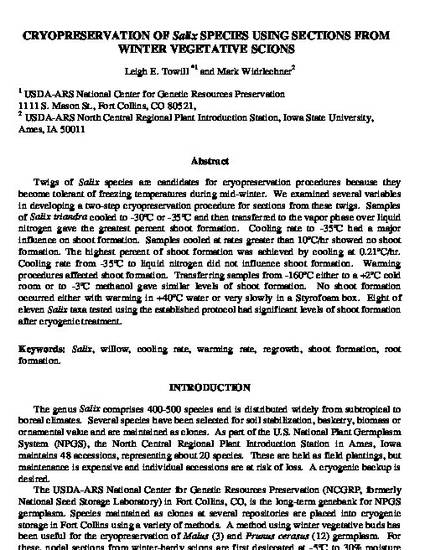
Article
Cryopreservation of Salix species using sections from winter vegetative scions
CyroLetters
Document Type
Article
Disciplines
Publication Date
1-1-2004
Abstract
Twigs of Salix species are candidates for cryopreservation procedures because they become tolerant of freezing temperatures during mid-winter. We examined several variables in developing a two-step cryopreservation procedure for sections from these twigs. Samples of Salix triandra cooled to-30°C or-35°C and then transferred to the vapor phase over liquid nitrogen gave the greatest percent shoot formation. Cooling rate to-35°C had a major influence on shoot formation. Samples cooled at rates greater than 10°C/hr showed no shoot formation. The highest percent of shoot formation was achieved by cooling at 0.21°C/hr. Cooling rate from-35°C to liquid nitrogen did not influence shoot formation. Warming procedures affected shoot formation. Transferring samples from-160°C either to a +2°C cold room or to-3°C methanol gave similar levels of shoot formation. No shoot formation occurred either with warming in +40°C water or very slowly in a Styrofoam box. Eight of eleven Salix taxa tested using the established protocol had significant levels of shoot formation after cryogenic treatment.
Rights
Works produced by employees of the U.S. Government as part of their official duties are not copyrighted within the U.S. The content of this document is not copyrighted.
Language
en
File Format
application/pdf
Citation Information
Leigh E. Towill and Mark P. Widrlechner. "Cryopreservation of Salix species using sections from winter vegetative scions" CyroLetters Vol. 25 Iss. 1 (2004) p. 71 - 80 Available at: http://works.bepress.com/mark_widrlechner/8/

This article is from CyroLetters 25 (2004): 71–80.